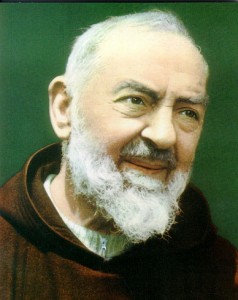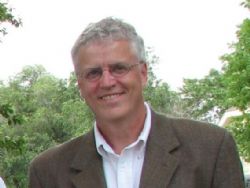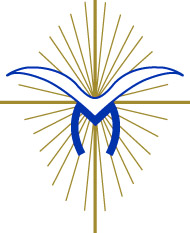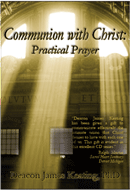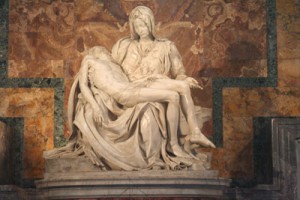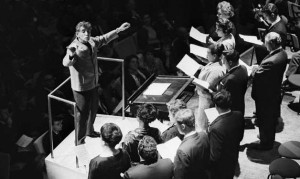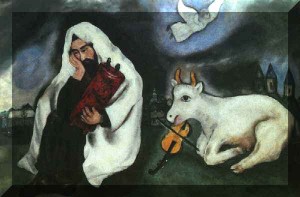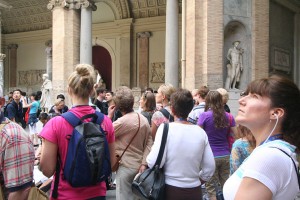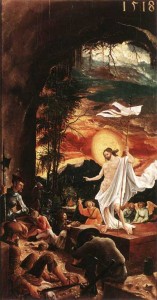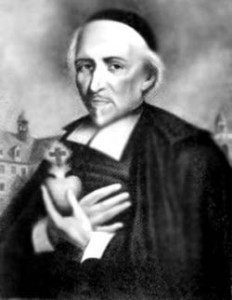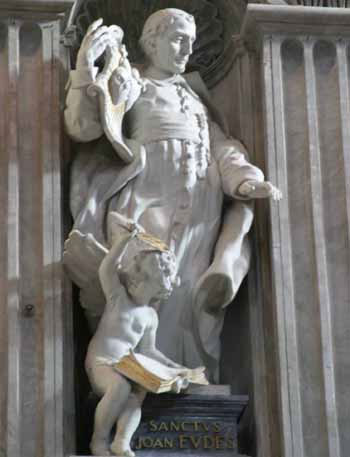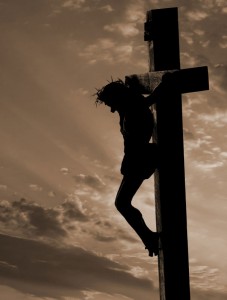Audio Prayer for the intercession of St.Padre Pio[powerpress]
“Pray, pray to the Lord with me, because the whole world needs prayer. And every day, when your heart especially feels the loneliness of life, pray. Pray to the Lord, because even God needs our prayers.”
Tags: catholic, catholic podcast, catholic prayer, cathollc spirituality, mp3 audio pray, mystic, mystic of the Church, padre pio
This entry was posted on Friday, September 23rd, 2011 at 12:01 am
You can follow any responses to this entry through the RSS 2.0 feed.
Tags: catholic, catholic podcast, catholic prayer, cathollc spirituality, st. teresa of avila, the interior castle
This entry was posted on Wednesday, September 21st, 2011 at 9:32 am
You can follow any responses to this entry through the RSS 2.0 feed.
Heart of Hope Part 2 – The agony of emotional suffering and opportunities for deeper union with Jesus; the reason for pastoral ministry
[powerpress = “deacon-james-keating”]
Deacon James Keating, PhD, the director of Theological Formation for the Institute for Priestly Formation, located at Creighton University, in Omaha, is making available to â€Discerning Hearts†and all who listen, his series of programs entitled “The Heart of Hopeâ€.
This extraordinarily popular series explores the work of suffering in the Christian life and how God can use it to transform the heart of the individual and the world. 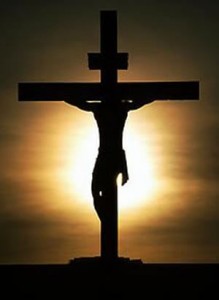
The “Heart of Hope† tackles a very tough subject…the gift of suffering in the Christian life. Deacon Keating guides us well.
For more information on the “Institute of Priestly Formation†and for other material available by Deacon Keating, just click here
Don’t forget to pickup a copy of “Communion with Christ†, it is one of the best audio sets on prayer…ever!
Check out Deacon Keating’s “Discerning Heart†page
Tags: abandonment, agony, alone, catholic, catholic podcast, catholic prayer, cathollc spirituality, creighton university, Deacon James Keating, Deacon Keating, discerning heart, hearts, institute for priestly formation, isolation, james keating, Jesus, lonliness, parish, PhD, suffering, theological formation
This entry was posted on Thursday, September 15th, 2011 at 3:38 am
You can follow any responses to this entry through the RSS 2.0 feed.
VATICAN CITY, 14 SEP 2011 (VIS) –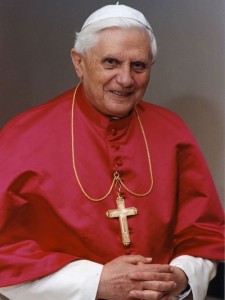
This morning the Holy Father travelled by helicopter from the Apostolic Palace at Castelgandolfo to the Vatican, where he held his weekly general audience in the Paul VI Hall. In his catechesis he dwelt on the first part of Psalm 22, focusing on the theme of prayers of supplication to God.
The Psalm, which remerges in the narrative of Christ’s Passion, presents the figure of an innocent man persecuted and surrounded by adversaries who seek his death. He raises his voice to God “in a doleful lament which, in the certainty of faith, mysteriously gives way to praise”.
The Psalmist’s opening cry of “my God, my God, why have you forsaken me?” is “an appeal addressed to a God Who appears distant, Who does not respond”, said the Holy Father. “God is silent, a silence that rends the Psalmists heart as he continues to cry out incessantly but finds no response”. Nonetheless, he “calls the Lord ‘my’ God, in an extreme act of trust and faith. Despite appearances, the Psalmist cannot believe that his bond with the Lord has been severed entirely”.
The opening lament of Psalm 22 recurs in the Gospels of Matthew and Mark in the cry the dying Jesus makes from the cross. This, Benedict XVI explained, expresses all the desolation the Son of God felt “under the crushing burden of a
mission which had to pass through humiliation and destruction. For this reason He cried out to the Father. … Yet His was not a desperate cry, as the Psalmist’s was”.
Violence dehumanises
Sacred history, the Pope continued, “has been a history of cries for help from the people, and of salvific responses from God”. The Psalmist refers to the faith of his ancestors “who trusted … and were never put to shame”, and he describes his own extreme difficulties in order “to induce the Lord to take pity and intervene, as He always had in the past”.
The Psalmist’s enemies surround him, “they seem invincible, like dangerous ravening beasts. … The images used in the Psalm also serve to underline the fact that when man himself becomes brutal and attacks his fellow man, … he seems to lose all human semblance. Violence always contains some bestial quality, and only the salvific intervention of God can restore man to his humanity”.
At this point, death begins to take hold of the Psalmist. He describes the moment with dramatic images “which we come across again in the narrative of Christ’s Passion: the bodily torment, the unbearable thirst which finds an echo in Jesus’ cry of ‘I am thirsty’, and finally the definitive action of his tormenters who, like the soldiers under the cross, divide among themselves the clothes of the victim, whom they consider to be already dead”.
At this point a new cry emerges, “which rends the heavens because it proclaims a faith, a certainty, that is beyond all doubt. … The Psalm turns into thanksgiving. … The Lord has saved the petitioner and shown him His face of mercy. Death and life came together in an inseparable mystery and life triumphed. … This is the victory of faith, which can transform death into the gift of life, the abyss of suffering into a source of hope”. Thus the Psalm leads us to relive Christ’s Passion and to share the joy of His resurrection.
In closing, the Pope invited the faithful to distinguish deeper reality from outward appearance, even when God is apparently silent. “By placing all our trust and hope in God the Father, we can pray to Him with faith at all moments of anguish, and our cry for help will turn into a hymn of praise”.
AG/ VIS 20110914 (630)
Published by VISarchive 02 – Wednesday, September 14, 2011
Tags: catholic, catholic podcast, catholic prayer, cathollc spirituality, pope benedict xvi, psalm 22
This entry was posted on Wednesday, September 14th, 2011 at 9:34 am
You can follow any responses to this entry through the RSS 2.0 feed.
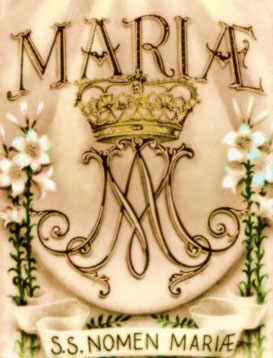 Ave Maria…the invocation of the name of Mary is a powerful prayer…Ave Maria…every time we say it we cry out to our Mother. What mother doesn’t rush to the aid of her child when he or she cries out her name? Hail Mary. Not just a name, but a supreme gift of grace to us all…the gift of a mother who loves unconditionally, who loves always, who loves each and every one of her children given to her by God.  Hail Mary, when we say it we unlatch the door and allow our mother in, when we say it we pick up the phone and converse with the greatest of human counselors, when we say it we acknowledge the reality of the presence of the “Woman” clothed with the Sun, with the moon under her feet, crowned with the stars who labors to see all of her children “birthed” into heaven. Mary….Mary….Mary.  The Holy Name of….Mary.
Ave Maria…the invocation of the name of Mary is a powerful prayer…Ave Maria…every time we say it we cry out to our Mother. What mother doesn’t rush to the aid of her child when he or she cries out her name? Hail Mary. Not just a name, but a supreme gift of grace to us all…the gift of a mother who loves unconditionally, who loves always, who loves each and every one of her children given to her by God.  Hail Mary, when we say it we unlatch the door and allow our mother in, when we say it we pick up the phone and converse with the greatest of human counselors, when we say it we acknowledge the reality of the presence of the “Woman” clothed with the Sun, with the moon under her feet, crowned with the stars who labors to see all of her children “birthed” into heaven. Mary….Mary….Mary.  The Holy Name of….Mary.
This has become for me a very precious feast day.  Once, when I was traveling on a personal pilgrimage alone, I was feeling achingly isolated, rejected and lost, literally thousands of miles from home. A terrible darkness had shrouded over me emotionally and spiritually. In a very poignant and unexpected way, Our Lady made her presence known to me on this date. It would involve an encounter with a little woman from Africa who looked like my grandmother and spoke no English, and a long plane ride home..this coming together would grow into a gentle, loving exchange  between strangers…I didn’t realize it, but it was what my broken “pierced” heart had been aching for.  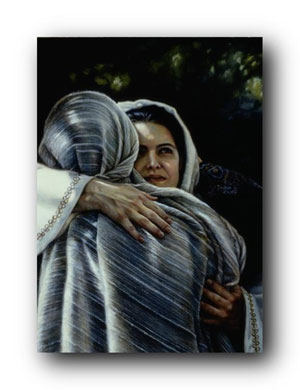 Without fanfare or expectation, out of nowhere came the name of Mary, literally…a moment which illuminated for me the bright light of the Blessed Mother’s presence, and not just at that particular moment in time. Like the brightest star in the night sky, it became clear to me that she had been there truly, truly guiding me all along, even in the darkest moments of doubt and pain.  That she had not, and would never, “leave me alone”.  That I was indeed responding to HER call and in turn she had responded to mine. Mary. It was she who traveled with me on that journey and who would continue to do so in the days and years ahead. Mary.
Without fanfare or expectation, out of nowhere came the name of Mary, literally…a moment which illuminated for me the bright light of the Blessed Mother’s presence, and not just at that particular moment in time. Like the brightest star in the night sky, it became clear to me that she had been there truly, truly guiding me all along, even in the darkest moments of doubt and pain.  That she had not, and would never, “leave me alone”.  That I was indeed responding to HER call and in turn she had responded to mine. Mary. It was she who traveled with me on that journey and who would continue to do so in the days and years ahead. Mary.
Well, the entirety of this story is really for another time, I just wanted to share with those who may read this, that I, unqualified and without hesitation,  with my whole unworthy heart, love Our Blessed Mother…I love “Mary”. I hope and pray you do too. If not, listen today for her name…call out to the one who is waiting…she WILL race to your aid. Mary. She is your mother, a gift to us all from her Son, our Savior, Jesus Christ. A precious, precious gift. Do not toss her aside.  She will never, ever leave you alone.
Father, in the video below, talks about the orgin of this feast day… it’s really quite a lovely homily.
Tags: ave maria, blessed mother, catholic, catholic podcast, catholic prayer, cathollc spirituality, holy name of mary
This entry was posted on Monday, September 12th, 2011 at 7:40 am
You can follow any responses to this entry through the RSS 2.0 feed.
EWTN Global Catholic Television Network: EWTN Live – Fr. Mitch Pacwa, SJ – Fr. David J. Simonetti – The Benefits of Spiritual Direction
Fr. Simonetti spoke on the topic of Spiritual Direction on EWTN last night, and spoke for a few minutes about his time with IPF’s Spiritual Direction Training Program
Tags: catholic, catholic podcast, catholic prayer, cathollc spirituality, David J. Simonetti, Global Catholic Television Network, spiritual direction
This entry was posted on Friday, September 9th, 2011 at 5:12 pm
You can follow any responses to this entry through the RSS 2.0 feed.
Heart of Hope Part 1 – The role of the Cross in the Christian life, suffering, prayer and and how it conquers evil
[powerpress = “deacon-james-keating”]
Deacon James Keating, PhD, the director of Theological Formation for the Institute for Priestly Formation, located at Creighton University, in Omaha, is making available to â€Discerning Hearts†and all who listen, his series of programs entitled “The Heart of Hopeâ€.
This extraordinarily popular series explores the work of suffering in the Christian life and how God can use it to transform the heart of the individual and the world. 
The “Heart of Hope† tackles a very tough subject…the gift of suffering in the Christian life. Deacon Keating guides us well.
.
For more information on the “Institute of Priestly Formation†and for other material available by Deacon Keating, just click here
Don’t forget to pickup a copy of “Communion with Christ†, it is one of the best audio sets on prayer…ever!
Check out Deacon Keating’s “Discerning Heart†page
Tags: catholic, catholic podcast, catholic prayer, Catholic Spirituality, cathollc spirituality, deacon, evil, hope, james keating, prayer, suffering, the cross
This entry was posted on Thursday, September 8th, 2011 at 4:32 pm
You can follow any responses to this entry through the RSS 2.0 feed.
DIALECTIC OF PRAYER: HUMAN CRY AND DIVINE RESPONSE
VATICAN CITY, 7 SEP 2011 (VIS) – This morning Benedict XVI travelled by helicopter
from the Apostolic Palace in Castelgandolfo to the Vatican for his weekly general audience in St. Peter’s Square.
Continuing a series of catecheses on the subject of “the school of prayer”, the Holy Father turned his attention to Psalm 3 which recounts David’s flight from Jerusalem when Absalom rose against him. “In the Psalmist’s lament”, the Pope said, “each of us may recognise those feelings of pain and bitterness, accompanied by faith in God, which, according the biblical narrative, David experienced as he fled from his city”.
In the Psalm, the king’s enemies are many and powerful, and the imbalance between David’s forces and those of his persecutors “justifies the urgency of his cry for help”. Nonetheless his adversaries “also seek to break his bond with God and to undermine the faith of their victim by insinuating that the Lord cannot intervene”.
Thus, the aggression “is not only physical, it also has a spiritual dimension” aimed at “the central core of the Psalmist’s being. This is the extreme temptation a believer suffers: the temptation of losing faith and trust in the closeness of God”, the Holy Father said.
Yet, as the Book of Wisdom says, the unrighteous are mistaken because “the Lord … is like a shield protecting those who entrust themselves to Him. He causes them to raise their heads in sign of victory. Man is no longer alone … because the Lord hears the cry of the oppressed. … This intertwining of human cry and divide response is the dialectic of prayer and the key to reading the entire history of salvation. A cry expresses a need for help and appeals to the faithfulness of the other. To cry out is an act of faith in God’s closeness and His willingness to listen. Prayer express the certainty of a divine presence which has already been experienced and believed, and which is fully manifested in the salvific response of God”.
Psalm 3 presents us “a supplication replete with faith and consolation. By praying this Psalm we share the sentiments of the Psalmist: a just but persecuted figure which would later be fulfilled in Jesus. In pain, danger and the bitterness of misunderstanding and offence, the words of this Psalm open our hearts to the comforting certainty of faith. God is always close, even in times of difficulty, problems and darkness. He listens, responds and saves.
“However”, the Pope added, “it is important to be able to recognise His presence and to accept His ways: like David during his humiliating flight from his son Absalom, like the persecuted righteous of the Book of Wisdom and, finally and fully, like the Lord Jesus on Golgotha. In the eyes of the unrighteous it appeared that God did not intervene and that His Son died, but for believers it was at that precise moment that true glory was manifested and definitive salvation achieved”.
The Pope concluded: “May the Lord give us faith, may He come in aid of our weakness and help us to pray in moments of anguish, in the painful nights of doubt and the long days of pain, abandoning ourselves trustingly to Him, our shield and our glory”.
AG/ VIS 20110907 (550)
PSALM 3 From the New Advent On-line Bible:
1 The psalm of David when he fled from the face of his sonAbsalom.
 hy, OÂ Lord, are they multiplied that afflict me? many are they who rise up against me.
hy, OÂ Lord, are they multiplied that afflict me? many are they who rise up against me.
3 Many say to mysoul: There is no salvation for him in his God.
4 But you, O Lord, are my protector, my glory, and the lifter up of my head.
5 I have cried to the Lord with my voice: and he has heard me from his holy hill.
6 I have slept and have taken my rest: and I have risen up, because the Lord has protected me.
7 I will not fear thousands of the people surrounding me: arise, O Lord; save me, O my God.
8Â For you have struck all them who are my adversaries without cause: you have broken the teeth of sinners.
9 Salvation is of the Lord: and your blessing is upon your people.
Tags: catholic, catholic podcast, catholic prayer, cathollc spirituality, pope benedict, prayer, psalms
This entry was posted on Wednesday, September 7th, 2011 at 7:30 am
You can follow any responses to this entry through the RSS 2.0 feed.
On Wednesday Pope Benedict XVI challenged the men and women of today’s
world to recover the deepest meaning of art, in its multitude of expressions, but particularly as the path of beauty which leads to God. And in doing so he also shared personal memories of how art had moved him to God with the five thousand pilgrims gathered for the general audience in the tiny village of Castel Gandolfo.
He said “On several occasions during this period, I have recalled the need for every Christian to find time for God, for prayer, amid the many occupations of our daily lives. The Lord Himself gives us many opportunities to remember Him. Today I will touch briefly on one of these channels that can bring us to God and also be of help in encountering Him: it is the path of artistic expression, part of that “path of Beauty “, of which I have spoken several times and which man today should recover in its deepest meaningâ€.
Pope Benedict continued “perhaps sometimes, before a sculpture, a painting, a few verses of a poem or a song, you have experienced deep within an intimate emotion, a sense of joy, that is, you have clearly perceived that in front of you there was not only mere matter, a piece of marble or bronze, a painted canvas, a series of letters or a combination of sounds, but something bigger, something that speaks, capable of touching the heart, of communicating a message; of elevating the soul. ”
“Works of art are the fruit of human creativity, which question the visible reality, trying to discover its deep meaning and to communicate it through the language of shapes, colours, sounds.” The work of art, in short, “is an open door on the infinite,” which “opens the eyes of the mind, of the heart.”
However, he added, “there are artistic expressions that are true paths to God, the supreme Beauty, indeed they help nurture our relationship with Him in prayer. These are works that are born of faith and express faith. One example of this is when we visit a Gothic cathedral; we are enraptured by the vertical lines that shoot up towards the sky and draw our eyes and our spirits upwards, while at the same time, we feel small, and yet eager for fullness … Or when we enter a Romanesque church: we are spontaneously invited to recollection and prayer. We feel as if the faith of generations were enclosed in these splendid buildings. Or, when we hear a piece of sacred music that vibrates the strings of our heart, our soul expands and helped to turn to God. A concert of music by Johann
Sebastian Bach, in Munich, directed by Leonard Bernstein, again comes to my mind. Afterthe last piece of music, one of the Cantate, I felt, not by reasoning, but in my heart, that what I heard had conveyed to me truth, something of the truth of the great composer’s faith and this pressed me to praise and thank the Lord and beside me was the Lutheran Bishop of Munich and spontaneously, feeling this, I said to him, you know, its true, a faith and beauty so strong and irresistibly expresses the presence and truth of God”.
Pope Benedict then turned spoke of how certain artists have touched our lives : “How many times have paintings or frescoes, the fruit of the faith of the artist, in their forms, their colours, their light, encouraged us to direct our thoughts to God and nourished in us the desire to draw from the source of all beauty. What the great artist, Marc Chagall, once
wrote remains true, that for centuries painters have dipped their paintbrush in that coloured alphabet that is the Bible. How many times, then can artistic expressions be occasions to remind us of God, to help our prayer or for the conversion of the heart! Paul Claudel, a poet, playwright, and French diplomat, in the Basilica of Notre Dame in Paris, in 1886, while he was listening to the singing of the Magnificat at Christmas Mass, felt God’s presence. He had not entered the church for reasons of faith, but to in search of arguments against Christians, and instead the grace of God worked in his heart”.
The Holy Father concluded: “I invite you to rediscover the importance of this path for prayer, for our living relationship with God. The cities and towns all over the world preserve works of art that express the faith and remind us of our relationship with God. Visiting places of art, it is not only an occasion for cultural
enrichment, but above all it can be a moment of grace, an encouragement to strengthen our relationship and our dialogue with the Lord, to stop and contemplate, in the transition from simple external reality to a deeper reality, the ray of beauty that strikes us, that almost wounds us in our inner selves and invites us to rise towards God. “
And then he greeted all English speaking pilgrims present: I am pleased to greet the English-speaking pilgrims and visitors here today, especially those from Scotland and Malta. Today we reflect on the need to draw near to God through the experience and appreciation of artistic beauty. Art is capable of making visible our need to go beyond what we see and it reveals our thirst for infinite beauty, for God. Dear friends, I invite you to be open to beauty and to allow it to move you to prayer and praise of the Lord. May Almighty God bless all of you!
Tags: art, catholic, catholic podcast, catholic prayer, cathollc spirituality, music, pope benedict xvi, prayer
This entry was posted on Thursday, September 1st, 2011 at 1:00 am
You can follow any responses to this entry through the RSS 2.0 feed.
Is Jesus Calling? A Spiritual Guide to Discerning Your Vocational Call with Fr. Paul Hoesing – episode 7: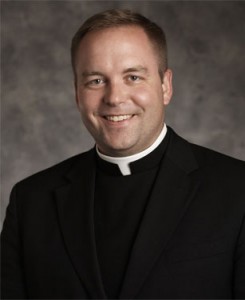 Â It’s all about relationship. Â What to do now.
 It’s all about relationship.  What to do now.
[powerpress]
1. Go to Mass, if possible, daily Mass
2. The sacrament of confession
3. Daily Prayer
4. Â Talk to a priest
5. Â Read the Gospels
6. Â Devotion to the Blessed Virgin Mary, the Mother of God
7. Â Eucharistic adoration
8. Â Live a life of virtue
9. Â Spiritual reading
10. Â Hang around good people
Based on “Is Jesus Calling You To Be A Catholic Priest: A helpful guide”, published by National Conference of Diocesan Vocation Director.
Fr. Paul Hoesing serves as the Vocation Director for the Archdiocese of Omaha, NE.
Check out “For Your Vocation.org“
Tags: catholic, catholic podcast, catholic prayer, catholic priest, cathollc spirituality, discernment, Fr, married life, Paul Hoesing, priesthood, vocation discernment
This entry was posted on Saturday, August 27th, 2011 at 10:35 pm
You can follow any responses to this entry through the RSS 2.0 feed.
[powerpress]
Part 1: Msgr. Esseff describes the difference between Exorcism and Deliverance:
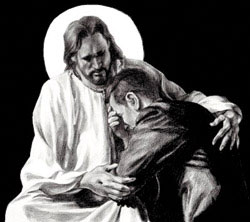
The role of the Bishop and the priest.  The power we have by virtue of our baptism. What is possession?  What is a curse?  The rite of Exorcism and the need for inner healing of the individual.  The ministry of Deliverance and how it differs from the need for Exorcism.  Addictions that effect the person and how . Priests and gifted individuals work in harmony to free the person from the evil spirit.  The wounds that contribute to the affliction experienced by the individual.  The need to distinguish between spiritual pain and psychological pain, and the need for the Sacrament of Reconciliation….”one good confession is worth 100 exorcisms.”  The role of the laity today in deliverance ministry.
[powerpress url=”http://discerninghearts.com/Esseff/Msgr._Esseff_Deliiverance_and_Exorcism_pt_2.mp3″]Download (right click & choose “Save Link As”)
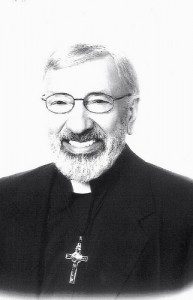
In part 2, after the intial recording, Msgr. Esseff  answers various questions posed on various topics:
The priesthood and the role of spiritual healing. Â Do we give the devil too much credit? Â The role of Mary. The power of the Cross. Â How do slip back into oppression or sin? Â How can we prevent that? Â The power of prayer in temptation.
visit Msgr. Esseff’s website “Building A Kingdom of Loveâ€
Tags: catholic, catholic podcast, catholic prayer, cathollc spirituality, powerpress, rite of exorcism
This entry was posted on Monday, August 22nd, 2011 at 4:37 pm
You can follow any responses to this entry through the RSS 2.0 feed.
A Prayer to Take Authority
[powerpress]
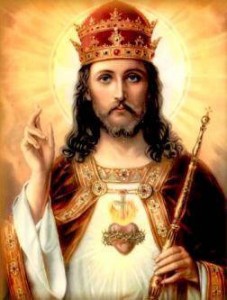
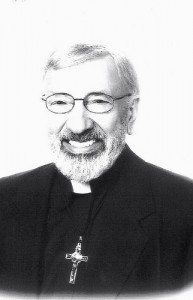 Msgr. Esseff teaches about the need for healing, protection and deliverance. Msgr. Esseff discusses the importance of the “Our Father”. He then leads the following prayer:
Msgr. Esseff teaches about the need for healing, protection and deliverance. Msgr. Esseff discusses the importance of the “Our Father”. He then leads the following prayer:
In the name of Jesus, I take authority and I bind all the powers and forces in the air, in the ground, in the water, in the underground, in the netherworld, in nature and in fire. Â You are the Lord over the entire universe and I give you the glory for your creation. Â In your name, I bind all demonic forces that have come against us and our families and I seal all of us in the protection of your precious blood that was shed for us on the cross.
Mary Our Mother, we seek your protection and intercession, with the Sacred heart of Jesus, for us and our families and surround us with your mantle of love to discourage the enemy.
St. Michael and our Guardian Angels, come and defend us and our families in battle against all the evil ones that roam the earth.
In the name of Jesus, I bind and command all the powers and forces of evil to depart right now away from us, our families, our homes, and our lands and I cast you at the foot of the cross to remain there forever. And I thank you Lord Jesus for you are a faithful and compassionate God, Amen.
Hail Mary, Full of Grace, the Lord is with thee.
Blessed art thou among women,
and blessed be the fruit of thy womb, Jesus.
Holy Mary, Mother of God, pray for us sinners now
and at the hour of our death. Â Amen.
visit Msgr. Esseff’s website “Building A Kingdom of Loveâ€
Tags: catholic, catholic podcast, catholic prayer, cathollc spirituality
This entry was posted on Monday, August 22nd, 2011 at 4:28 pm
You can follow any responses to this entry through the RSS 2.0 feed.
St. John Eudes,  the great disciple of the two hearts of  Jesus and Mary….it is ALL about the heart!Â
He believed in the unity of the hearts of Jesus and Mary and wrote:”You must never separate what God has so perfectly united. So closely are Jesus and Mary bound up with each other that whoever beholds Jesus sees Mary; whoever loves Jesus, loves Mary; whoever has devotion to Jesus, has devotion to Mary.”
We “heart” St. John Eudes!
May this great lover of the two hearts, pray for us!
                                           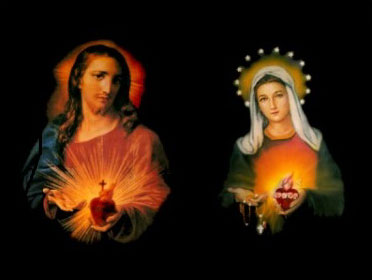
Tags: catholic, catholic podcast, catholic prayer, cathollc spirituality, hearts, immaculate heart, Jesus, Jesus and Mary, Jesus sees Mary, John Eudes, John Eudes Statue, sacred heart, st john eudes, two hearts
This entry was posted on Friday, August 19th, 2011 at 7:11 am
You can follow any responses to this entry through the RSS 2.0 feed.
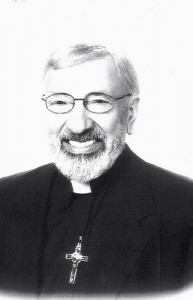 Msgr. Esseff discusses the Sacrament of Reconciliation. What is a “core wound”? What prevents us from being Christ in the world today? Who do we encounter in the confessional? What is the role of the Cross in the confessional? What does Jesus see from the Cross? What is the role of the Holy Spirit in revealing the “core wound”?
Msgr. Esseff discusses the Sacrament of Reconciliation. What is a “core wound”? What prevents us from being Christ in the world today? Who do we encounter in the confessional? What is the role of the Cross in the confessional? What does Jesus see from the Cross? What is the role of the Holy Spirit in revealing the “core wound”?
visit Msgr. Esseff’s website “Building A Kingdom of Love”
Tags: catholic, catholic podcast, catholic prayer, cathollc spirituality, sacrament of reconciliation, the confessional
This entry was posted on Tuesday, August 16th, 2011 at 11:12 am
You can follow any responses to this entry through the RSS 2.0 feed.
Tags: blessed virgin mary, catholic, catholic podcast, catholic prayer, cathollc spirituality, the assumption
This entry was posted on Monday, August 15th, 2011 at 1:02 am
You can follow any responses to this entry through the RSS 2.0 feed.

